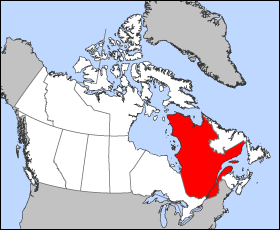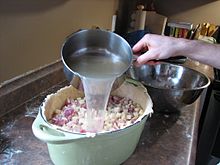Quebec is the largest province in terms of area and the second largest in terms of population Canada.

Regions

places
- Montreal
- Ville de Quebec - Capital of the province
- Gatineau - sister city Ottawas on the river of the same name, parts of the federal government are located here.
- Trois-Rivières - Halfway between Montréal and the Ville de Québec
- Rimouski, Rivière-du-Loup - on the eastern bank of the lower reaches of the St. Lawrence River
- Saguenay - the city lies on the Rivière Saguenay on its way into the Saint Lawrence River.
Other goals
- Mont-Tremblant - the most important ski resort in the Laurentine Mountains
background
The correct German spelling Quebeck, is rarely used anymore. It used to be called Lower Canada. It is the largest province in Canada and also the one with the largest francophone population. Of the 7.5 million inhabitants who are called the Quebecers (French Québéquois), the majority are French as their mother tongue. It is the only province in North America where this is the case.
language
In the province of Québec, the national language is French. French and English are spoken in all institutions under the federal government (Canada). In Montréal, a large proportion of the population is English-speaking, and both languages are used in the tourism industry. So you can 'survive' very well with English, especially as a tourist. If you use a few sentences in French (greeting, thank you, etc) you will enjoy all the hospitality of Quebecers. Canada is supposed to be officially bilingual, but it is only in some areas of the country and in Quebec.
getting there
By plane
The Montreal-Trudeau Airport is the second largest in Canada with direct flights from many European cities. Most visitors to Quebec will end up here.
Other airports are in Quebec and Mont-Tremblant with only regional connections. The far west of the province may be best over Ottawa to reach.
mobility
You can only really be mobile with a car. There are also services between the larger cities Long-distance buses. The rail network is on the Quebec-Montreal-Ottawa/Toronto limited.
.jpg/220px-P1070757_(3203775504).jpg)
If you want to cross the St. Lawrence River by car, you will find bridges to the city Quebec. Afterwards there are only ferries to the Atlantic:
- Traverse Rivière-du-Loup - Saint-Siméon. The ferry holds 100 cars and crosses the river in 65 minutes. Departures four times a day in midsummer. The drop-off point in Rivière-du-Loup is at Rue Hayward, in Saint-Siméon the ferry lands near the Rue du Quai.Price: $ 45 per car plus $ 19 per person (children 7–12 years $ 12.70, seniors $ 17.20; as of summer 2015).
- Another ferry, whose tariffs are similar, commutes even further east, between Trois pistoles and Les Escoumins. (website)
Tourist Attractions
- 1 Gatineau Park. Natural park with countless activities.
- 2 Parc national de Miguasha. The smallest of the natural parks in this province. Since 1999 he has belonged to the UNESCO World Heritage Site.

activities
- → See also Amusement Parks in Quebec (QC)
- Camping in the various national parks
- Whale watching in the St. Lawrence River and the Gaspésie
- Observation of moose, wolves with a nature guide in Jacques-Cartier-Park
- Ski (downhill and cross-country skiing) in the various parks and ski stations
- Dog sledding
Regular events
- Winter Carnival in Quebec City
- Maple syrup season in spring
- Observation of wild geese in spring and autumn on the banks of the St. Lawrence River in the vicinity of Québec
- Music festival in early July in Quebec City
- Montréal Jazz Festival
- 'l'été indien' Indian summer - a unique natural spectacle at the end of September and beginning of October
shop
If you want to buy French books, you can look out for branches in Quebec Renaud-Bray-Keep chain that are always very well sorted. An alternative is that ArchambaultChain that offers canned music and other media in addition to books. With videos and DVDs, however, you have to keep in mind that because of the regional code and the color format, they usually cannot be played on European devices.
kitchen
Quebec's cuisine derives its variety of flavors from a mixture of influences. It has a solid French base and is enriched by the contributions of the Indian peoples and other cultural communities who have found their home in the province. This mix of culinary cultures makes Quebec cuisine what it is today.
It is worth keeping an eye out for Canadian or French restaurants in Québec that offer multi-course meals at a fixed price ("table d’hôte"). Travelers who are used to only having a small bite to eat at lunchtime and all the more generous in the evening can save a lot of money if they change over for the duration of their trip and move the main meal to noon. The good and elegant restaurants usually have lunch options that are significantly cheaper than the evening menu. Danger, diner means lunch in Canadian French, not dinner; one often reads the expression in menus midi. Dinner is served as a souper designated. Table d'hote are special meals at a fixed price. Eating out is quite expensive in Québec, even simpler cafes or bars are expensive. The café culture in Québec is like most European countries. So it should be very easy to find a quaint cafe around the Marche Champlain or around the castle.
Many delicatessens and markets offer a wide variety of cheeses from local farms. Specialties of the region are brie or camembert-like cheeses made with raw milk (Lait cru) getting produced. These cheeses have flavors and textures not normally found in North American cheeses of the same type.
- Maple syrup is the thickened sap of the sugar maple. The juice (30-50 liters of juice are needed for one liter of syrup) is then boiled down into maple syrup and traditionally used to sweeten many dishes. It is also eaten with ham, sausages and savory things. A culinary tradition of Quebec is Sugar shack (German sugar hut, fr. cabane à sucre), Maple products are eaten to Quebec folklore. At the beginning of spring, in March and April, you go as a group, similar to the kale tours in northern Germany. A variety of dishes are served with maple syrup, from bacon to pies to desserts, everything is sweetened. In addition, sweet maple wine or maple beer is drunk. Most sugar shacks sell their maple products locally (maple butter, taffies, and syrup) at low prices. If you want to participate, it makes sense to reserve in advance. Some sugar shacks are open all year round.
- 1 Sucrerie de la Montagne, 300 Chemin Saint-Georges, Rigaud, QC J0P 1P0 (about an hour's drive from Montreal). Tel.: 1 450-451-0831. Maple syrup farm with shop, restaurant with syrup menus, overnight accommodation. You can find out more about the production and culinary options of the syrup. The main season is February to April, when there are many events.Open: 9:00 a.m.-8: 00 p.m. daily.
.jpg/146px-Maple_Sap_Water_Pails_(13789944725).jpg)
Maple sap is collected,
.jpg/220px-Sand_Road_Maple_Sugar_Farm_Boiler_(13789760044).jpg)
boiled down to maple syrup,
.jpg/138px-Cabane_à_sucre_!_(8260523097).jpg)
poured in the snow
.jpg/220px-Maple_syrup_popsicle_(6974621697).jpg)
and then curled up into a tuffy.
- At Poutine it is French fries with curd cheese and gravy. If you want to try the calorie bomb, you should do so, even if the European prejudice that this dish is actually inedible is confirmed.

Poutine

typical dishes
- Tourtière québecoise is a type of meat pie, typical of the Saguenay-Lac-St-Jean region. It consists of different types of meat (mostly beef and pork, often game, cut into small cubes) and diced potatoes, which are baked together in a baking dish.

still poured with broth and off to the oven

that's done Tourtière québecoise
- In spring, the very fine-tasting tips of the ostrich fern (Matteuccia struthiopteris) eaten as wild vegetables. In English they will Fiddleheads called, the twisted fern tips look like the heads of violins. You can find it on French menus at Tete de violon. You can buy them frozen all year round. They have to be boiled for 15 minutes before they can be enjoyed; they should not be eaten raw.

Fried chicken breast with mashed potatoes and fiddlehead fern
nightlife
The legal age for drinking alcohol in public in Quebec is 18 years.
Practical advice
It is more respectful to address the French-speaking citizens of Quebec as Quebecers (m. Québécois, f. Québécoise) than to call them French-Canadians. Most of Quebec's Francophone citizens feel more like Québécois than Canadians. Québec is not France, many prefer to be referred to as "Francophone" (which only refers to the French language) instead of "French" (which is ambiguous as French could infer national citizenship). Anglophones are not offended if they are called Canadians; they consider themselves both.
Postcodes for Québec begin with G (Québec City and eastern Québec), H (Montréal and Laval), and J (West Québec). H0H 0H0 are reserved seasonally.
security
Quebec is generally a safe area, with the possible exception of a few unsafe neighborhoods in Montreal and Quebec City. Visitors should use common sense when traveling, just like they usually lock cars and watch out for valuables.
In winter and spring it is important to ensure that rental cars are equipped with winter tires.
climate
There are four different seasons in Quebec, offering great views of nature and a variety of activities.
- winter (November to late March): Quebec's extremely low temperatures and an abundance of snowfall make skiing, snowboarding, sledding, snowmobiling, and dog sledding all possible. In December, Quebec turns into a snow-covered, white dreamland. In March and April the maple syrup celebrations take place in the sugar huts (see kitchen).
- spring (April and May): April can still be relatively cold and snowfall. April feels like winter should finally be over. In May nature awakens, the trees fall and it begins to bloom.
- summer (June to September): Summers in Quebec are hot and the season is full of festivals and outdoor activities.
- autumn (September to the end of October): The leaves change color and create breathtaking colorful landscapes.
literature
Web links
- https://www.quebec.ca (fr) - Québec Official Website



.jpg/146px-Maple_Sap_Water_Pails_(13789944725).jpg)
.jpg/220px-Sand_Road_Maple_Sugar_Farm_Boiler_(13789760044).jpg)
.jpg/138px-Cabane_à_sucre_!_(8260523097).jpg)
.jpg/220px-Maple_syrup_popsicle_(6974621697).jpg)




